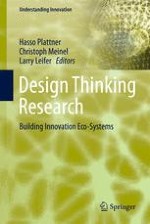2014 | OriginalPaper | Chapter
Sharing Knowledge Through Tangible Models: Designing Kickoff Workshops for Agile Software Development Projects
Authors : Markus Guentert, Alexander Luebbe, Mathias Weske
Published in: Design Thinking Research
Publisher: Springer International Publishing
Activate our intelligent search to find suitable subject content or patents.
Select sections of text to find matching patents with Artificial Intelligence. powered by
Select sections of text to find additional relevant content using AI-assisted search. powered by
